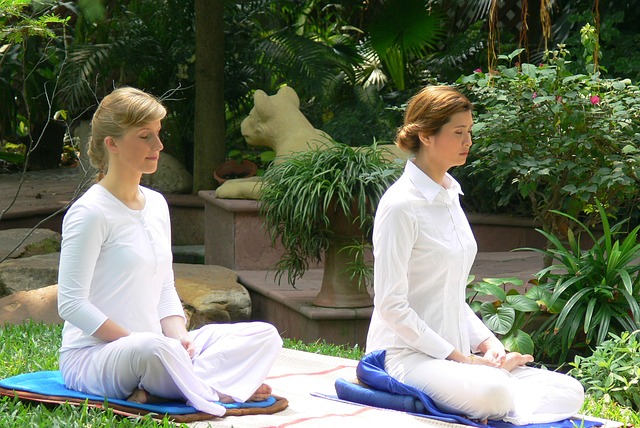
For years, I wanted to create a solid and consistent meditation practice, but here’s my major confession: even after I became a meditation teacher, I still struggled with meditating regularly.
I felt like a fraud and I couldn’t figure out what was holding me back.
I knew—I really knew—how good meditation is. Not only in the short-term (enjoying an immediate and increased sense of well-being), but also in the long-term (improving overall states of health and increasing the capacity to cope with challenging situations). So, why didn’t I simply meditate as much as I dreamed?
The truth is, knowing the how and why of doing something doesn’t necessarily translate to sustainable action. This resistance is so common that I became curious about why it can be difficult to integrate a new behavior into our lives—and what to do about it.
As a Professor in Holistic Health Education, Mind-Body Medicine and Health Behavior Change, I’ve discovered that we have what’s called an “Immunity to Change” (Kegan and Lahey, 2009). The entirety of our being—our “self-system,” the physical body, mind, emotions and spirit—likes stability.
Our self-system will see any new behavior as a threat, because it perceives change as destabilizing. This immunity to change mechanism is actually designed to protect us.
I also discovered that to effectively start something new, it’s important to make small shifts—allowing a gradual process of change so there is less of a challenge to the self-system. Below are five powerful tools we can use to help integrate meditation into our lives:
Under-Promise.
Commit to doing less than you think you can. When we try to make drastic changes to our current behaviors, we often don’t reach our goal, feel discouraged and then discontinue the new behavior altogether. Under-promising is about setting goals that you know you can meet. In fact, under-promising asks you to be honest with yourself about what you can accomplish, and then plan to do even less.
How to Under-Promise:
Step 1: Be honest with yourself about how much time and energy you have for this new behavior.
Step 2: Increase the time frame you give yourself to complete things. If you think something will take one hour, give yourself two.
Step 3: Decrease the number of times you commit to engaging in something new. Consider how many times you can engage in this new behavior, then commit to one or two times less than that.
So, instead of planning to meditate 30 minutes a day for six days the first week, you might plan two five- minute meditations, but only if you’re certain you can get that done. If achieved, your sense of accomplishment will inspire you to do more next week.
Pair Your Habits.
Habit-pairing is connecting a new behavior with an already well-established behavior. Think about something you do regularly, then connect your meditation practice to that behavior. Consider where you can realistically pair a new behavior. For example, if you’re a morning person, pair your meditation with brushing your teeth. Or, if you’re a night person, consider meditating after you brush your teeth for bed.
You know yourself best, so do what would work best for you.
Pick the Best Meditation Style for You.
There are many different kinds of meditation, and none is “one size fits all.” Some people enjoy sitting in silence, others enjoy listening to guided imagery, and yet others prefer to walk, shake or dance.
Here are three basic meditation styles:
1. Concentrative Meditation.
Focused awareness on objects, words, thoughts, images or phrases.
Purpose: Shifting one’s internal state toward more peace or joy.
Examples: Guided imagery, relaxation meditations, mantras, repeated prayers.
2. Mindful or Awareness Meditation.
Awareness itself is the focus of this type of meditation (e.g. awareness of thoughts, feelings or sensations).
Purpose: To simply observe and accept what is happening in one’s experience, rather than trying to change anything.
Examples: Mindful eating exercises, mindful breathing and integrative restoration meditations.
3. Expressive or Active Meditation.
Movement and expending energy is the focus of this style of meditation.
Purpose: Using vigorous movement allows the body to release excess energy and brings the body and mind to a state of peace and stillness.
Examples: Vigorous yoga, walking, shaking, dancing, whirling.
Try different styles of meditation to help you find what works best for you. When meditating is enjoyable and you feel the benefits, you’ll want to continue the practice.
Find an Accountability Partner or Group.
The goal of accountability partnerships and groups is to check in on what you have committed to accomplishing. To set up an accountability partnership, discuss how often you’d like to check in (the more often, the better). Decide on the means of communication (e.g. email, social media, phone, text). An especially helpful accountability tool is creating a plan if your partner or group hasn’t heard from you after a certain amount of time.
Discover Your Competing Commitments.
We usually think of resistance to change as a bad thing, but often resistance signifies something important. We may have what are termed “competing commitments” getting in the way. A competing commitment (Kegan & Lahey, 2009) is something that you have committed to in the past in order to get a certain personal need met. When you begin a new behavior and it conflicts or competes with that prior commitment, suddenly resistance will come up.
What can you do when your new commitment is bumping up against that old competing commitment?
Shift from self-blame to curiosity when you experience resistance. Curiosity helps to focus on learning about yourself.
Imagine your life if you effectively make this change. Are there additional aspects of your life that will also change (e.g. relationships)?
Notice if you feel any discomfort about any of these secondary changes. That’s a sign that there may be a competing commitment at play.
Take a look at the things you are doing (or not doing) that are getting in the way of you reaching your goal. Is there some way those resistant behaviors are serving you?
If you have identified a competing commitment and the underlying benefit for that commitment, see if you can find another way to get the same benefit while still accomplishing your new goal.
Understanding that our behaviors are an extension of our healthy desire to care for ourselves can help us reframe our frustration about any resistance we feel to these new behaviors.
Ultimately, understanding our personal meditation style, implementing some well-planned structure and getting to know our underlying motivations can be a powerhouse combination in helping us to create a sustainable meditation practice.
~
References:
Kegan, R. and Lahey, L.L. (2009). Immunity to change: How to overcome it and unlock the potential in yourself and your organization (Leadership for the common good). Harvard Business Review Press: Boston, MA.
Author: Nina Fry-Kizler
Image: Pixabay / Trevor Ellestad/Flickr
Apprentice Editor: Julie Balsiger; Editor: Toby Israel








Read 1 comment and reply